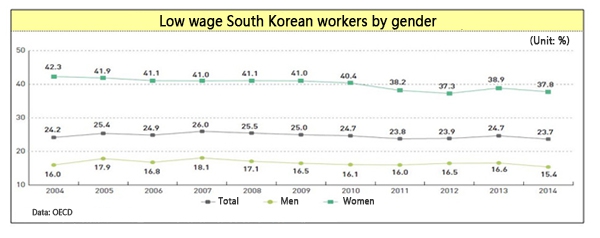#low_wage_workers #gender_gap #low_social_expenditure
 |
|
Low wage South Korean workers by gender
|
More women than men in low-wage work, and despite increase, South Korea’s welfare spending still roughly half OECD average
Around one-quarter of South Korean wage earners are engaged in low-wage work, a percentage that has remained virtually unchanged with just a 0.5 percentage point drop in the past 10 years, a study shows.South Korea’s public and social welfare expenditures were also found to be just half the average for OECD member countries.
The Ministry of Health and Welfare announced the findings as part of a report titled “Social Security Viewed through Statistics 2016” published on Mar. 2. The social security statistics consist of 162 representative indicators in areas such as family, health, work, employment security, poverty, and environment.
The findings published on Mar. 2 showed 23.7% of workers in low-wage jobs, the third highest rate in the OECD after Ireland the US. The indicator is a representation of wage inequality, with higher percentages of low-wage workers signifying not only labor market inequality but a greater likely of working poverty.The category of low-wage workers includes those earning less than two-thirds the median salary for all wage earners. By 2014 standards, it represented an hourly wage below 6,712 won (US$5.84), or approximately 1.4 million won (US$1,220) per month.
The rate of low-wage employment was far higher for women than men by a margin of 37.8% to 15.4% – a number attributable to the large percentage of female workers in low-income industries such as hospitality and restaurants or in irregular positions. The percentage of workers in low-wage jobs was also down by only 0.5 percentage points from the 24.2% recorded in 2004, indicating almost no improvement in the preceding decade.
South Korea’s public and social welfare spending was found to remain at a low level. In 2014, South Korea spent 10.4% of GDP on public and social welfare, or roughly half the 21% average for the OECD’s 30 member countries.At the same time, the Ministry of Health and Welfare noted, “While the OECD average increased by 0.98% a year from 2000 to 2016, South Korea’s annual rate of increase in public and social welfare spending over the same period was high at 5.4%.”The rate of national Basic Livelihood Benefits payment was calculated at 3.2% for 2015, with 16,460,000 beneficiaries. The rate showed almost no increase from 2001, when it stood at 3%.
By Hwangbo Yon, staff reporter

